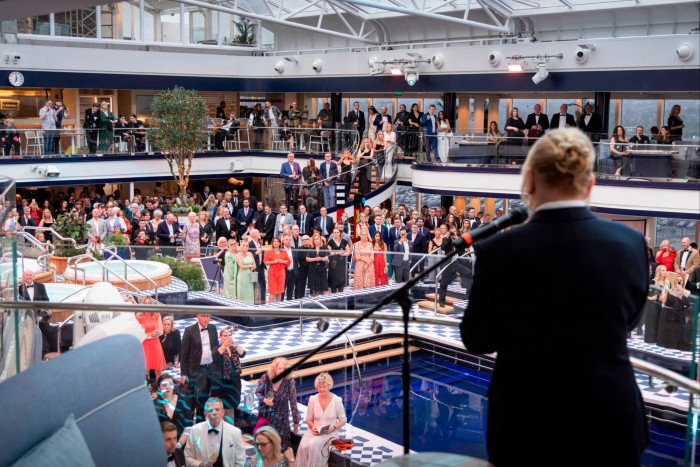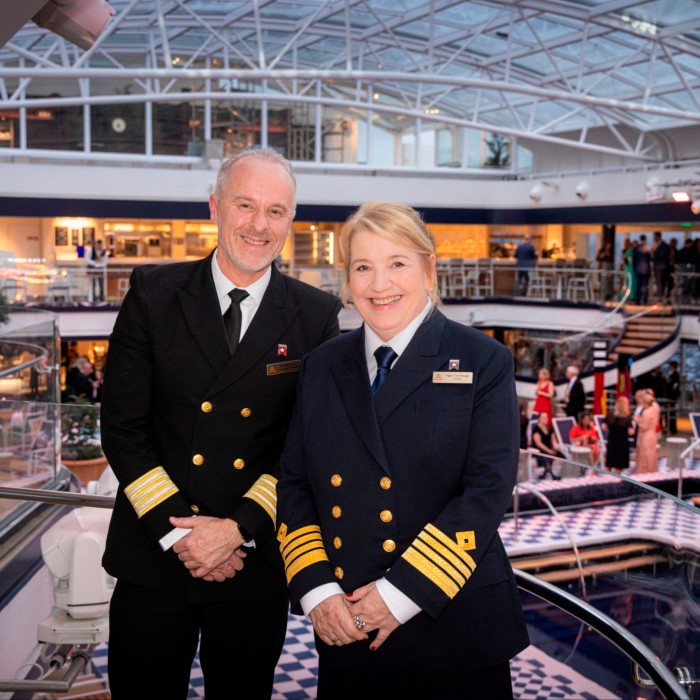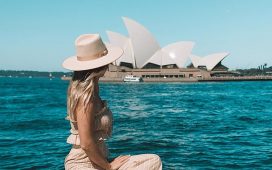I still get a jolt of excitement when I see electric cars. Last Wednesday at Southampton docks, when the sky was as grey as a tax return, my eyes settled on a few hundred Teslas, freshly imported. A Tesla sign announced proudly: “Our mission is to accelerate the world’s transition to sustainable energy.”
But Elon was out of luck. We were not ready for the future just yet. Our minibus was not in Southampton to pick up a Model Y; we had to come to see the world’s newest cruise ship. Just a few metres from the Tesla forecourt, so near that you could probably have stretched a charging cable, sat Cunard’s 322-metre, $600mn pleasure palace, the Queen Anne.
The Queen Anne is shiningly, achingly new — we were here for a launch party. But in energy terms, it’s already a relic. If battery-powered Teslas are at the future of transport, the Queen Anne is the past. It is not powered by electricity or hydrogen or even (the still-bad-for-the-climate) liquified natural gas. It uses marine gas oil, refined from crude oil.
She will spend the next couple of decades chugging around Europe, polluting various picturesque port cities. Friends of the Earth estimate that a passenger in a standard cabin on a typical cruise ship is responsible for 300kg of carbon emissions per day, or around six times as much as an average land-based tourist. The difference narrows a little if you include flights, but many cruise-goers fly to their destination too. I looked back at the neatly parked Teslas, and felt forlorn.
The fuel is just part of a broader weirdness. Cruise ships represent a holiday unmoored not just from land, but from reality itself. Whether this is appealing depends, I suppose, on whether you like reality. Either way, and even if you’re familiar with cruise ships, you will surely still be caught off-guard by the oddness of the experience.


In Southampton, we looked up at the Queen Anne’s sky-blocking vastness: 13 floors of floating luxury. We were shepherded towards the ship by dozens of Cunard employees — kindly women who looked like they’d come straight from a tallest sunflower contest in Somerset. We stepped aboard, and saw the staff switch abruptly from pure English to mostly Filipino.
The Queen Anne — or as the Pravda-esque Tannoy announcements insisted on calling her, “the beautiful Queen Anne” — had only emerged from a dockyard near Venice a few days earlier. We, a mix of journalists, travel agents and faded celebrities, were its first passengers before she began her maiden voyage to Lisbon.
These are boom times for the cruising industry. In Covid, cruise ships briefly became death traps for elderly holidaymakers. But memories are short. Cruise ships are now going viral in a different way: a recent story featured a Florida couple who have decided to live permanently on cruises, finding it cheaper than living on land (and with less driving than a motorhome). The world’s largest cruise ship, the Icon of the Seas, launched in January. Viking Holdings, a river cruise specialist which bans under-18s, last week floated successfully on the stock exchange.
For Cunard, a subsidiary of cruise giant Carnival, the launch of the Queen Anne means that it has four ships in operation for the first time since 1999. The Queen Anne is “a destination in itself,” one of the officers enthused to me. “It’s a floating hotel!” It’s also a floating shopping centre, leisure centre and perhaps retirement home.
With a gross tonnage of 113,000, the Queen Anne is larger than its siblings Queen Victoria and Queen Elizabeth (only trumped by Cunard’s flagship, Queen Mary 2). There’s a grand piano in the reception area, a casino and a 835-seat theatre. The walls are lined with the largest curated art collection at sea, some 4,000 pieces, not all of them bad. Chef Michel Roux Jr., relocating a few elements of his Le Gavroche experience from Mayfair to the Queen Anne, reports that the galley had “every bit of kit . . . I’m just overwhelmed by the size of it.” The miracle is how this floats at all.
I tour the wellness centre, with its large sauna and offers of Botox injections. Ian McEwan wrote in his novel Saturday that, after our civilisation collapses, the old folk will crouch around peat fires and tell their disbelieving grandchildren of the luxury of hot showers in winter – “of thick white towels as big as togas, waiting on warming racks.” If I am ever one of these old folk, I will tell them instead of the Queen Anne’s Himalayan salt sauna, of its ice bath and Irish pub — all propelled thousands of miles across seas by large quantities of fossil fuel. Did we not realise the madness?
My room is one of the spacier cabins at the back of the vessel — with two large TVs, a bath and shower and a sofa. The large balcony looks over a ship unloading scrap metal, so I use my imagination. Without it, I might forget I’m at sea at all.
Outside, the Queen Anne is not quite ready for her close-up. Staff queue up for their uniforms. Full cardboard boxes pile up in corridors. Men hurry around, fixing lights and coffee machines. There is an air of gentle anarchy.
Occasionally, I catch sight of one of the on-board celebrities such as royal commentator Jennie Bond, gardener Alan Titchmarsh, actor Celia Imrie, and cricket commentator Henry Blofeld. One other celebrity, who shall remain anonymous, told me he found the environment “prison-like”. But for a captive audience, and a paying client, he might be persuaded to step aboard and scintillate.
There is a genre of magazine-writing that is scathing of cruise holidays. A cynical, middle-aged writer goes on board and quickly despairs. Indeed, it’s easy to be rude about cruising. Cruises are nature holidays for people who can’t really like nature, foreign travel for people who don’t really want to leave home, the Mediterranean for people who don’t want to get their feet damp or sandy. David Foster Wallace, the US writer who wrote about a cruise in the Caribbean in 1996, reported hearing adult passengers ask whether snorkelling would involve getting wet “and what time the Midnight Buffet is”.



But all this now rings hollow. First, in the battle between the snobs and the cruisers, the cruisers have won. It was Harper’s magazine that published Foster Wallace’s despairing piece. Its one-time stablemate, Harper’s Bazaar, is now the official partner of Queen Anne’s spa and wellness centre.
Second, humanity is no worse on cruise ships. There were no real-life passengers aboard the Queen Anne. But the workers I spoke to were unfailingly courteous. It was strange having people find my every need interesting: I suppose this is what it’s like being appointed CEO. At the Queens Grill, the top restaurant, they brought me excellent food and a 52-page wine menu. I wasn’t sure how comfortable I was being the source of their nine-month separation from their families, but you get the gist.
For Foster Wallace, the delusion of cruising was that you could truly be satiated. The ship infantilises you; it encourages you to demand more. However many restaurants are on offer — the Queen Anne has 14, including a steakhouse, a Japanese and an Indian, as well as a dozen bars — it will not be enough.
For me, the delusion is the façade of cleanliness. You have little sense of what you are churning into the air and seas. The images of polished cruise ships surrounded by glassy open water have long misled us. The Titanic burned more than 800 tonnes of coal a day. The Queen Elizabeth 2, which Cunard retired in 2008, once burned 433 tonnes of oil a day, equivalent to one and a half tonnes per passenger per transatlantic crossing. Cunard declined to say how much the Queen Anne will burn, but we can safely say that it will be a lot. Enough of flight-shame, how about float-shame?
Cruising is the most polluting way to travel, much worse than flying. The Queen Anne will visit Europe’s two most polluted ports, Barcelona and Civitavecchia (Rome), and six of the top ten, once you include Palma, Hamburg, Southampton and Funchal. Although the ship uses low-sulphur fuel, in 2022 Europe’s 218 cruise ships emitted much more sulphur than all of its nearly 300mn cars, according to the campaign group Transport and Environment. Venice has banned the ships from its historic centre; a few other cities are restless.



One basic way that cruise ships can reduce their emissions is by hooking up to electricity when they are in port. The Queen Anne can do this, but many ships don’t bother, partly because buying electricity is more expensive than running their engines.
Friends of the Earth rates Cunard’s environmental performance ‘D minus’ (Carnival, Cunard’s Florida-based parent, only gets an F). Aboard the Queen Anne, an “Environment Notice” does tell passengers to put their rubbish in the bin.
Instead Cunard makes a play of its British heritage. The barely digestible guff on the Queens Grill’s dinner menu says that Cunard’s history “has rested on a royal backbone”. This sounds so uncomfortable that it nearly puts me off the miso asparagus.
“In just 12 short years Queen Anne achieved a great deal, not least the unification of England and Scotland,” it continues. Historians also mention Anne’s role winning Britain the right to be sole supplier of slaves to Spain’s colonies of South America. But that’s enough history. We’re here to enjoy the replicas of Princess Diana’s engagement ring and Kate Middleton’s tiara, both on display in the boutiques.
In fairness, Cunard has not gone nuts on its history. Mostly the past is hinted at, through Art Deco décor. This is presumably in hope of attracting a younger clientele. A Californian travel agent told me that the likely market for the ship were people “from their late sixties to their eighties”. But someone else thought that people in their fifties could be tempted. Then again, the Queen Anne’s swimming pools are so small that you could jump in and miss — suggesting they are mostly for decoration, not actual exercise.
The Queen Anne has capacity for 2,996 passengers and 1,225 crew. That is below the Icon of the Seas’s 5,610 passengers, but bigger than the ultra-luxury ships, such as those operated by Silversea, which cater to fewer than 1,000. Presumably that creates community: whereas I bumped into Titchmarsh but wondered how often I would see him in the course of a week’s cruise.


Then, after just a few hours on the boat, I started to wonder if the real problem was that the ship wasn’t big enough. I wanted the unpredictability of the real world. I also wanted air. Padding along the corridors, I felt a nascent desire to smash open a window — if only I could find one. Finally outside, I lingered by one of the huge lifeboats and read its unrealistic warning: “Read instruction manuals before using.”
If you like walking, or a world where not everyone is always in an unchanging hierarchy, a cruise ship is a constraining existence. After a single night, a fellow traveller had noticed the limitations of his stateroom. “I called my missus. I said, you and me, in this room, for seven days — we’re having an argument.” Another woman, arriving at breakfast in the restaurant she had dined the night before, sighed to her partner: “Are we at the same table? Let’s switch seats just to mix it up.”
I sat at my breakfast, flicking through a complimentary copy of World of Cruising magazine. I certainly felt well-served yet also sure that I couldn’t relax somewhere where the only vegetation is plastic trees. I checked out, meeting half a dozen more charming staff members on the way. I stepped back on land, and was both cheered and disappointed to see the Teslas still on the forecourt.
Details
Henry Mance was a guest of Cunard (cunard.com). A six-night cruise from Southampton to Rome on the Queen Anne costs from £584 per person; a nine-night transatlantic crossing costs from £769
Find out about our latest stories first — follow FTWeekend on Instagram and X, and subscribe to our podcast Life and Art wherever you listen

